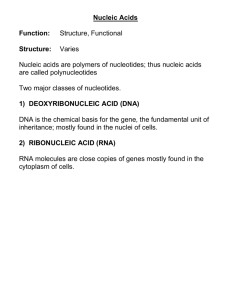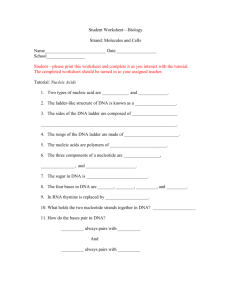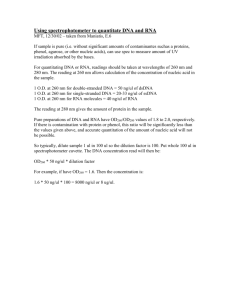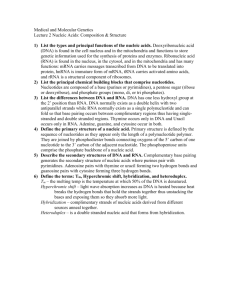Nucleotides & Nucleic Acids
advertisement
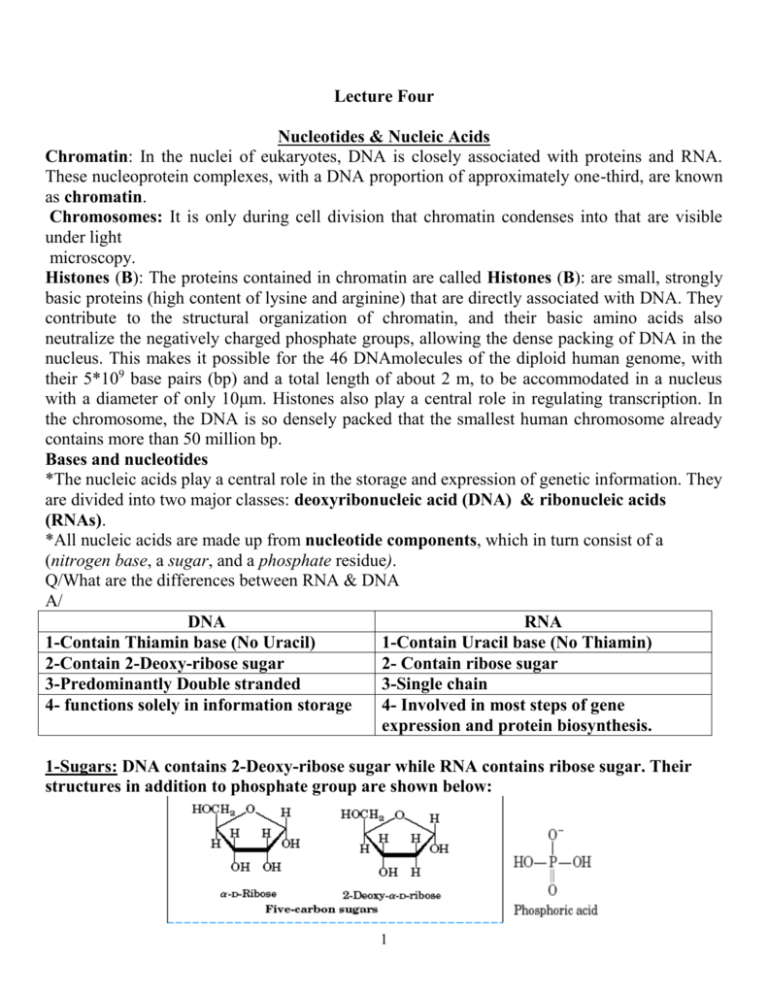
Lecture Four
Nucleotides & Nucleic Acids
Chromatin: In the nuclei of eukaryotes, DNA is closely associated with proteins and RNA.
These nucleoprotein complexes, with a DNA proportion of approximately one-third, are known
as chromatin.
Chromosomes: It is only during cell division that chromatin condenses into that are visible
under light
microscopy.
Histones (B): The proteins contained in chromatin are called Histones (B): are small, strongly
basic proteins (high content of lysine and arginine) that are directly associated with DNA. They
contribute to the structural organization of chromatin, and their basic amino acids also
neutralize the negatively charged phosphate groups, allowing the dense packing of DNA in the
nucleus. This makes it possible for the 46 DNAmolecules of the diploid human genome, with
their 5*109 base pairs (bp) and a total length of about 2 m, to be accommodated in a nucleus
with a diameter of only 10μm. Histones also play a central role in regulating transcription. In
the chromosome, the DNA is so densely packed that the smallest human chromosome already
contains more than 50 million bp.
Bases and nucleotides
*The nucleic acids play a central role in the storage and expression of genetic information. They
are divided into two major classes: deoxyribonucleic acid (DNA) & ribonucleic acids
(RNAs).
*All nucleic acids are made up from nucleotide components, which in turn consist of a
(nitrogen base, a sugar, and a phosphate residue).
Q/What are the differences between RNA & DNA
A/
DNA
RNA
1-Contain Thiamin base (No Uracil)
1-Contain Uracil base (No Thiamin)
2-Contain 2-Deoxy-ribose sugar
2- Contain ribose sugar
3-Predominantly Double stranded
3-Single chain
4- functions solely in information storage
4- Involved in most steps of gene
expression and protein biosynthesis.
1-Sugars: DNA contains 2-Deoxy-ribose sugar while RNA contains ribose sugar. Their
structures in addition to phosphate group are shown below:
1
2- Nitrogen bases: The bases that occur in nucleic acids are aromatic heterocyclic compounds
derived from either pyrimidine or purine. Five of these bases are the main components of
nucleic acids in all living creatures. The purine bases (adenine (abbreviation Ade, not “A”!)
and guanine (Gua) and the pyrimidine base cytosine (Cyt), uracil (Ura) is only found in RNA.
In DNA, uracil is replaced by thymine (Thy).
# the 5-methyl derivative of uracil. 5-methylcytosine also occurs in small amounts in the DNA
of the higher animals. A large number of other modified bases occur in tRNA and in other types
of RNA.
NH2
N
O
N
N
NH
Purines:
N
H
N
H
N
N
Adenine
Guanine
NH2
O
N
Pyrimidines:
N
H
NH2
O
NH
O
N
H
Thymine
Cytosine
NH
O
N
H
O
Uracil
Note: Small quantities of additional purines and pyrimidines occur in DNA and RNAs.
Examples are shown below:
Figure: four uncommon nitrogen bases found in human, bacteria & viruses nucleic acids
Note: Some naturally occurring purines including caffeine (in coffee & tea), theobromine
(in cacao), & theophylline (in tea)
2
Nucleosides: (Nitrogen base+Sugar)
When a Nitrogen base is N-glycosidically linked to ribose or 2-deoxyribose , it yields a
nucleoside. The nucleoside adenosine (abbreviation: A) is formed in this way from adenine
and ribose, for example. The corresponding derivatives of the other bases are called guanosine
(G), uridine (U), thymidine (T) and cytidine (C).
*When the sugar component is 2-deoxyribose, the product is a deoxyribonucleoside. e. g., 2deoxyadenosine (dA).
O
NH2
N
N
NH
N
N
N
N
HO
N
NH2
HO
O
O
H
H
OH
H
H
H
H
H
H
OH
H
H
2-Deoxyguanosine
2-Deoxyadenosine
NH2
O
O
N
NH
NH
N
HO
O
N
HO
H
OH
O
O
H
H
H
H
2-Deoxycytidine
O
HO
O
H
N
O
H
H
OH
H
H
2-Deoxythymidine
H
H
OH
H
OH
H
2-Deoxyuridine
Nucleotides: (Nitrogen base+Sugar+Phosphoric acid)
In the cell, the 5-OH group of the sugar component of the nucleoside is usually esterified
with phosphoric acid to produce nucleotides.e.g.2-Deoxythymidine (dT) therefore gives rise to
2-deoxythymidine-5-monophosphate (dTMP), one of the components of DNA.
*If the 5_phosphate residue is linked via an acid–anhydride bond to additional phosphate
residues, it yields nucleoside diphosphates and triphosphates—e. g., ADP and ATP, which are
important coenzymes in energy metabolism.
In nucleosides and nucleotides, the sugars and bases are linked by an N-glycosidic bond
between the C-1 of the sugar and either the N-9 of the purine ring or N-1 of the pyrimidine ring.
3
O
NH2
N
N
N
O
-O
P
N
O
N
-O
O
P
O
H
O-
H
OH
H
H
H
N
NH2
O
O
H
O-
NH
N
H
H
OH
H
H
2-Deoxyguanosine-5-monophosphate
2-Deoxyadenosine-5-monophosphate
O
O
NH2
NH
NH
N
N
O
-O
P
-O
O
N
O
O
P
O
OH
OH
H
H
H
OH
H
OH
H
H
N
O
-O
O
O
H
O
P
O
O
OH
H
2-Deoxycytidine-5-monophosphate 2-Deoxythymidine-5-monophosphate
O
H
H
OH
H
OH
2-Deoxyuridine-5-monophosphate
Importance of Nucleotides: nucleotides play a variety of important roles in all cells:
1-They are the precursors of DNA and RNA. 2-They are essential carriers of chemical energy
(ATP and to some extent GTP). 3-They are components of the cofactors NAD, FAD, Sadenosylmethionine, and coenzyme A, 4- They are components of activated biosynthetic
intermediates such as UDP-glucose and CDP-diacylglycerol. 5- cAMP and cGMP, are cellular
second messengers.6- controlling numerous enzymatic reactions through allosteric effects on
enzyme activity.
3́, 5́́́́ cyclic AMP (cAMP)
methionine
Adenosine triphosphate (ATP).
S-adenosyl
SYNTHETIC NUCLEOTIDE ANALOGS ARE USED IN CHEMOTHERAPY
Synthetic analogs of purines& pyrimidines have numerous applications such as 1- The
purine analog allopurinol, used in treatment of hyperuricemia and gout, inhibits purine
biosynthesis and xanthine oxidase activity, 2- Treatment of cancer
Q/Explain how some synthetic analogs of purines & pyrimidines used in the treatment of
cancer?Give examples
A/ Their toxic effects reflect 1-inhibition of enzymes essential for nucleic acid synthesis or 2their incorporation into nucleic acids with resulting disruption of base-pairing. Oncologists
4
employ 5-fluorouracil and 6-mercaptopurine, which are incorporated into DNA prior to cell
division.
#polynucleotides _
If the phosphate residue of a nucleotide reacts with the 3́-OH group of a second
nucleotide, the result is a dinucleotide with a phosphoric acid diester structure. Dinucleotides
of this type have a free phosphate residue at the 5́ -end and a free OH group at the 3́- end. They
can therefore be extended with
additional mononucleotides by adding further phosphoric acid diester bonds. This is the way in
which polynucleotides {ribonucleic acid(RNA)}, while those consisting of
deoxyribonucleotide monomers are called {deoxyribonucleicacid (DNA)}.
RNA
Ribonucleic acids (RNAs) are polymers consisting of nucleoside phosphate components that are
linked by phosphoric acid diester bonds. The bases the contain are mainly uracil, cytosine,
adenine, and guanine, but many unusual and modified bases are also found in RNAs.
Functions: RNAs are involved in all the individual steps of gene expression and protein
biosynthesis.
Three main types of RNA:
A. Ribosomal RNA (rRNA): The great majority of RNA which is a structural and
functional component of ribosomes. Ribosomal RNA is produced from DNA by
transcription in the nucleolus, and it is processed there and assembled with proteins to
form ribosome subunits. The bacterial 16S-rRNA shown in Fig. A, with 1542
nucleotides (nt), is a component of the small ribosomae subunit, while the much smaller
5S-rRNA (118 nt) is located in the large subunit.
B. Messenger RNAs (mRNAs): transfer genetic information from the cell nucleus to the
cytoplasm. Due to the varying amounts of information that they carry, the lengths of
mRNAs also vary widely. Their lifespan is usually short, as they are quickly broken
down after translation.
C. Transfer RNAs (tRNAs): function during translation. They are small RNA molecules
consisting of 70–90 nucleotides, which “recognize” specific mRNA codons with their
anticodons through base pairing. At the same time, at their 3_ end they carry the amino
acid that is assigned to the relevant mRNA codon according to the genetic code. The
molecule contains a high proportion of unusual and modified components. These include
pseudouridine (Ψ), dihydrouridine (D), and many methylated nucleotides such as 7methylguanidine (m7G).
Note: Small nuclear RNAs (snRNAs): are involved in the splicing of mRNA precursors.
They associate with numerous proteins to form “spliceosomes.”
5
Figure: A segment of one strand of a DNA molecule in which the purine and pyrimidine
bases guanine (G), cytosine (C), thymine (T), and adenine (A) are held together by a
phosphodiester backbone between 2′-deoxyribosyl moieties attached to the nucleobases by an
N-glycosidic bond.
Molecular genetics: overview
Nucleic acids (DNA and various RNAs) are of central importance in the 1-storage, 2transmission, and 3-expression of genetic information. The decisive factor involved is their
ability to enter into specific base pairings with each other.
A.Expression and transmission of genetic information:
*Storage: The genetic information of all cells is stored in the base sequence of their DNA
(RNA only occurs as a genetic material in viruses).
*Genes: are transcribable segments of DNA that code for inheritable structures or functions . It
is estimated that the mammalian genome contains 30 000–40 000 genes, which together account
for less than 5% of the DNA which consists of approximately 5x10 9 base pairs (bp). Most
genes code for proteins—i. e., they contain the information for the sequence of amino acid
residues of a protein (its sequence).
*Codon: consisting of a sequence of three base pairs (a triplet) of DNA. Every amino acid
residue
is represented in DNA by a codon.
e.g. A DNA codon for the amino acid phenylalanine, for example, is thus TTC.
6
I-Replication. During cell division, all of the genetic information has to be passed on to the
daughter cells. To achieve this, the whole of the DNA is copied. In this process, each strand
serves as a matrix for the synthesis of a complementary second strand.
II-Transcription. For the genetic information stored in DNA to become effective, it has to be
rewritten (transcribed) into mRNA. DNA only serves as a template and is not altered in any
way by the transcription process. As DNA itself is not involved in protein synthesis, the
information is transferred from the nucleus to the site of synthesis in the cytoplasm. To achieve
this,
the template strand in the relevant part of the gene is transcribed and leave the nucleus as
messenger
RNA (mRNA).
*Transcription is catalyzed by DNA–dependent RNA polymerases enzyme.
III-Translation. Mature mRNA enters the cytoplasm, where it binds to ribosomes, which
convert the mRNA information into a peptide sequence. the DNA codes for the primary
structure of proteins. The “language” used in this process has four letters (A, G, C, and T). All
of the words (“codons”) contain three letters (“triplets”), and each triplet stands for one of the
20 proteinogenic amino acids.
* The ribosomes consist of more than 100 proteins and several RNA molecules (rRNA).
rRNA plays a role as 1-a ribosomal structural element and 2-involved in the binding of mRNA
to the ribosome and 3-formation of the peptide bond.
Amino acid activation. Before binding to the ribosomes, tRNAs are loaded with the correct
amino acids by specific ligases. B. Amino acid activation: Some 20 different amino acid tRNA
ligases in the cytoplasm each bind one type of tRNA with the corresponding amino acid.
7
Figure: (Amino acid activation; Formation of aminoacyl-tRNA
DNA
A. DNA: structure: deoxyribonucleic acids (DNAs) are polymeric molecules consisting of
nucleotide building blocks. Instead of ribose, however, DNA contains 2́-deoxyribose, and the
uracil base in RNA is replaced by thymine. It is observed that the amounts of adenine and
thymine are almost equal and the same applies to guanine and cytosine. intact DNA consists of
two polydeoxynucleotide molecules (“strands”). Each base in one strand is linked to a
complementary base in the other strand by H-bonds. In addition, the two strands
have to be intertwined to forma double helix. In all living cells, DNA serves to store genetic
information.
■ Genetic information is encoded in the linear sequence of four deoxyribonucleotides in DNA.
■ The double-helical DNA molecule contains an internal template for its own replication and
repair.
. A two-step reaction, involving the enzymeaminoacyl-tRNA synthetase, results in the
formation of aminoacyl-tRNA.
A
B
Figure: A-Base pair rule: Cytosine & Guanosine bind by three H-bonds while Thymidine, or
Uracil, & Adenosine bind by two H-bonds. B- Complementarity of strands in the DNA
double helix.The complementary antiparallel strands of DNA follow the pairing Rules.
8
Figure: Watson-Crick model for the structure of DNA.
Replication of DNA. The preexisting
FIGURE:
or “parent” strands
become separated, and each is
the Template for
biosynthesis of a complementary
“daughter”
strand.
9

